ZIL-157 (1958)
 Soviet 6x6 military truck - c800,000 made.
Soviet 6x6 military truck - c800,000 made.
The ZIL-157 is a Soviet and Russian medium-tonnage truck with increased cross-country ability manufactured by the Likhachev Plant (ZIL). The ZIL-157 was mass-produced since 1958, mainly for the both Civilian needs and Armed Forces. Its cab a repeat of the ZIS-151's with minor changes. In time, the mass-produced ZIL-157 appeared soon obsolete and subsequently replaced in the 1970s by the ZIL-131 and Ural-375. A total of 797,934 in all modifications were produced, making it the largest Soviet truck production after the WW2 U7 (Based on the lend-lease
Stubaker US6). Created at the end of 1954, production started in 1958 and ended in 1991, IL stopping in 1978) and Novouralsk taking on. But the very last were made in 1994 in specialties. The antiquated, basically WW2 Soviet comfort cabin was improved in between with heater and an electric fan powered by the engine cooling system whereas suspension shock absorbers were improved. Despite of this, it's jarring to imaging this copy of the 1942 US6 was basically produced unchanged until after the end of the cold war... Note: As the subject is huge, expect upfates in the future and one-offs (like the 157K tractor for the S-125 SAM trailer)...
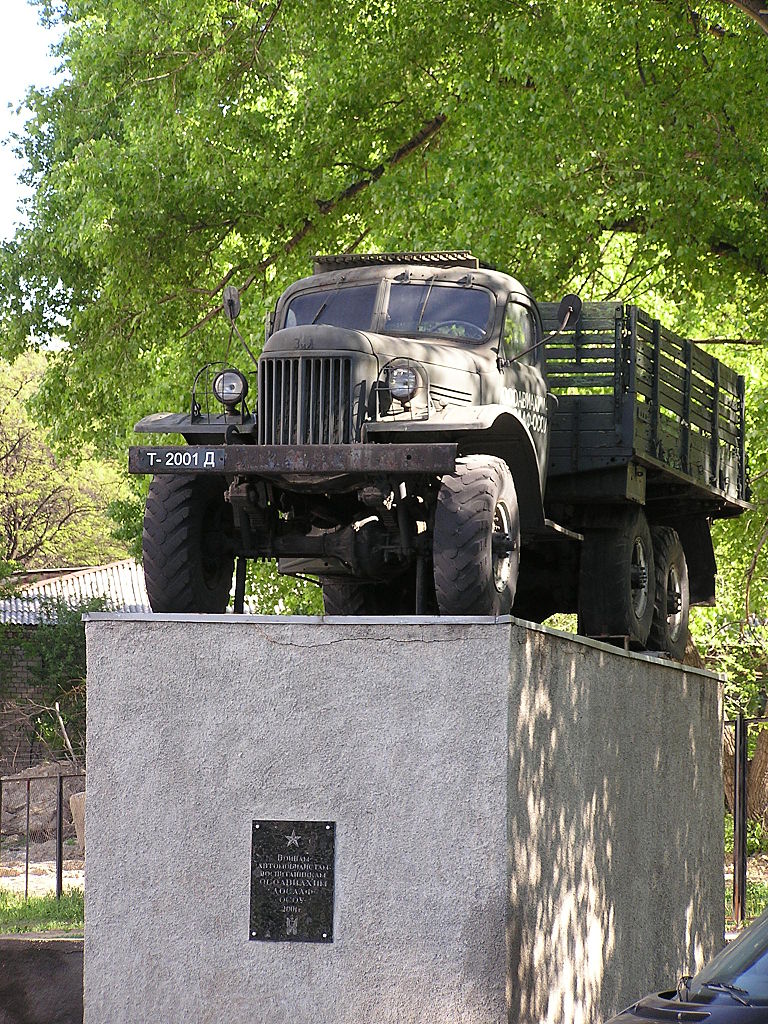 ZIL-157 on a Monument in Donetsk
ZIL-157 on a Monument in Donetsk
Development
Before the ZIL-157 was the ZIL-151. It was the first postwar Soviet Medium Truck, a general-purpose model based on the ZIS-6 and lend-lease Studebaker US6. It was developed in many versions included the armored BTR-152 armored personnel carrier and BAV 485 amphibious vehicle. Having issues only solved by the ZIL-157, it was not widely exported but was licence-built as the Jiefang CA-30 in China. With some 150,000 delivered until 1958 it saw it fair share of action in the early cold war. In all c150,000 were made. For a neophyte, both the ZIL-151 and 157 looked really the same. There were still many differences some external, but most internal or just hidden.
The genesis of the ZIL-157 is really abour gradually improving the ZIL-151. The name ZIL came from the old ZIS (Staling) whic became the “Likhachev” Factory after 1953. The ZIL-157 was an improved version, with larger single tires in place of the smaller, narrower ones paired on the rear drive axles. The other great innovation were the adjustable tire pressure which was adopted from vehicles such as the armoured BTR-152 based on the ZIL-151. The centralized management of tire pressure was a bonanza to overcome all types of terrain, deep mud or snow, and sand.
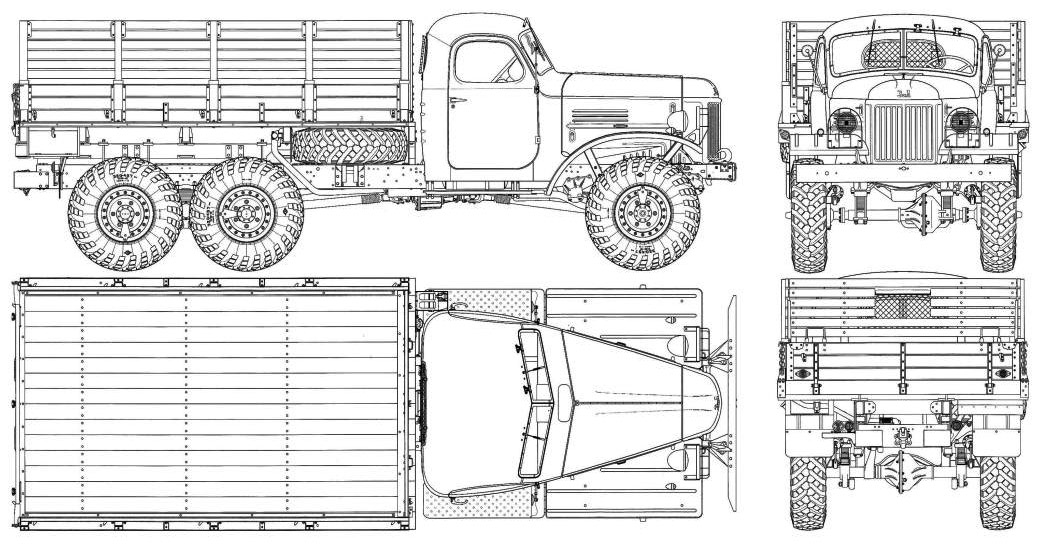 ZIL 157
ZIL 157
With the larger tire and bigger engine, this really solved all critics on the ZIL-151. From 1961 an automatic control was provided to adjust the pressure automatically. Its not clear from when factory and state trials weent on, probably between 1954 to 1957. Production was authorized from 1958 and the serie went on unchanged until 1961 then appeared the 157K from 1961 to 1964, and ultimately the the ZIL-157KD from 1976 to 1982, most being export models a the ZIL-131 replaced it in USSR.
The ZIL-157 was a 3 metric ton cargo truck, so 3t (6,615 lbs) load capacity on all terrain. On flat rooads it could be loaded up to 7,500 kilograms plus trailer. As a troop carrier, normal load was between 12-16 soldiers on folding bunks. It seems a self-recovery winch, second innovation of the design, was mostly seen from 1961 onwards.
This was a very successful military truck for the time, albeit altready looking obsolescent opr old-fashioned. It was very rugged and reliable, more agile than the ZIL-151 and in 1958 it was presented in the West, at Brussels, and was awarded the Grand Prix of the World Exhibition.
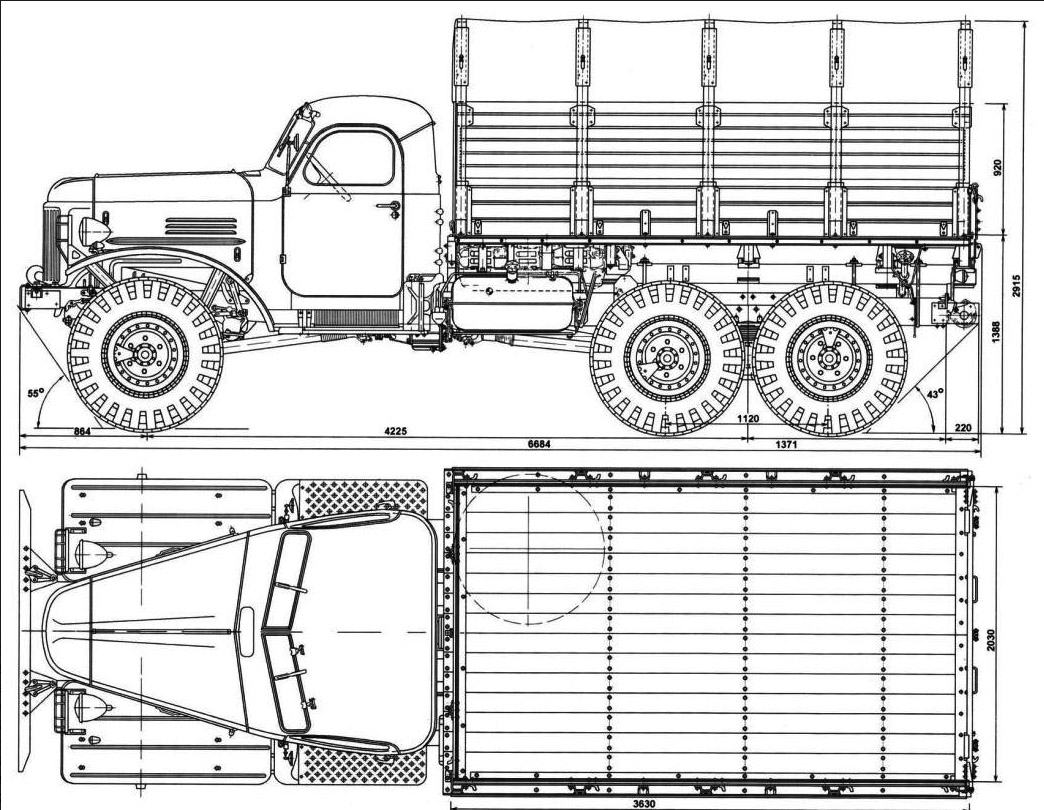 ZIL 157
ZIL 157
From 1961, the ZIL-157K had its weight distribution on the axles changed, it also had a new gearbox with single-plate clutch, telescopic shock absorbers and a stlighty more powerful engine (see data below). in 1978, production was transferred to UAMZ (Ural Automobile Engine Plant), a branch of AvtoZIL, under the index ZIL-157KD, the ultimate version which production ran until 1991 mostly for export and the civilian market, as it was very popular in collective farms and logging companies in Siberia. Still used today in thes remote areas it is still praised for its simplicity and reliability making it easy to maintain and repair, helped by a massive production easing the stockpile of parts.
Design of the ZIL-157
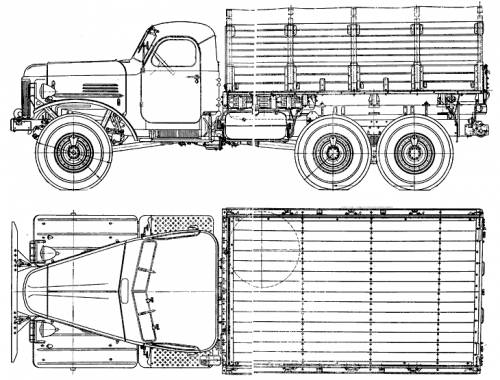 ZIL 157
ZIL 157
The ZIL-157 6x6 truck replaced the ZIL-151 in production from 1958. In 1961 the improved ZIL-157K was introduced, replaced in 1966 by the more powerful ZIL-131 6x6 3,5t truck. Despite of this, production of the ZIL-157 went on until 1978 at the main plant and until 1990 in another one for the civilian amrket and exports. In appearance the ZIL-157 resembled the ZIL-151 with a slightly different cab also fitted on late production ZIL-151s allowing to share many parts, windows, windshields, dahsboards, rear mirrors, etc. But the greatest different was they were fitted with single instead of dual rear wheels on the ZIL-151.
The layout was conventional, with the engine at the front, two-door, fully enclosed cab, and rear cargo area with a metal bed frame and wooden platform with folding sides, bench seats on either side that can be folded up when carrying cargo, and a drop tailgate. If required, they could be fitted with bows and tarpaulin cover. Standard equipment includes a cab heater, an engine preheater and many vehicles also have a winch from 1961.
The ZIL-157 had a relatively complex transmission with five cardan shafts:
-Intermediate, between the transfer case and gearbox
-To the front axle
-To the middle axle
-Two cardan shafts with an intermediate bearing unit on the middle axle approached the rear axle.
The ZIL-157 used larger wheels and tires of 12.00-18 and the centralized tire pressure inflation system borrowed from the BTR-152 was something completely new on a truck. Along with the self-recovery winch made it able to cross the worst possible dirt roads or even mule paths. The central inflation also could maintain overpressure in the tires after a puncture, thanks to the compressor.
On virgin snow or marshy terrain it was possible to briefly reduce pressure to 0.7 kg/cm² enlaring considerably the tire's contact band. Speed however should not exceed 10 kph. The tire life also was reduced to just 150 km. When operating all the time at normal pressure of 2.8 kg/cm² the guaranteed mileage is 10,000 km... In winter careful monitoring of the cooling system was necessary and insulating covers were added to the radiator. Its only serious drawback was the lack of hydraulic power steering. This truck required authentic "truck drivers" stocky and pretty muscular.
 ZIL-157 at Patriot Park
ZIL-157 at Patriot Park
General layout
Engine and performances
Precise Specifications:
Curb weight 5,540 kgs, Gross weight 10,190 kgs.
Front axle load 2,4t (gross 2.77t), rear bogie load 3,14t (gross 7.42t)
Ground clearance 31 cm
Length 6,684 x width 2,315 x height 2,360 mm, with awning — 2,915 mm
Wheelbase 4,225 mm
The ZIL-157 produced from 1958 to 1961 had a rated power of 104 hp or 76.5 kW, top speed of 65 km/h and the gearbox ratios were like the ZIS-150 and ZIS-151:
1st gear - 6.24; 2nd gear - 3.32; 3rd gear - 1.898; 4th gear - 1.00; 5th gear — 0.81; reverse — 6.70. The transfer case gear ratios were the same as the ZIS-151: 1st gear — 2.44; 2nd gear — 1.24. This model had a 6ST-100 battery as well.
The 1962-78 model had a new gearbox, new engine 157K 5.5 liters 6-cyl. water cooled rated for 109 hp or 80.2 Kw. Maximum crankshaft speed is 2,800 rpm, top speed 60 kph.
Gear ratios are now on 1st gear: 7.44, 2nd gear: 4.10, 3rd gear: 2.29, 4th gear: 1.47, 5th gear: 1.00 and Reverse: 7.09. The Transfer case ratios are on 1st gear: 2.27
2nd gear: 1.16, Final drive ratio: 6.67.
From 1958 to 1990 they shared the exact same tire size of 12.00-18 from front to rear. Turning radius was 11.2 m. The front suspensions were longitudinal semi-elliptical springs with hydraulic double-acting shock-absorbers and rear bogie with semi-elliptical springs. Main forward brakes used air. The parking brake was mechanical. They came out in standard with a 12 V Electrical system and two Batteries ST-84.
Variants of the ZIL-157
 ZIL-157K blueprint
ZIL-157K blueprint
In the USSR, modifications of the basic ZIL-157 model were produced:
ZIL-157K: Basic model since 1961, the design used parts of the ZIL-130
ZIL-157-R experimental model, with equally spaced axles along the base of the car, while the suspension of each axle was independent.
ZIL-157V truck tractor
ZIL-157KV truck tractor since 1961
ZIL-157Yu Tropical version
ZIL-157G with shielded equipment
ZIL-157KG with shielded equipment since 1961
ZIL-157E export version
ZIL-157E with special chassis with two gas tanks (150 l each)
ZIL-157KD basic model since 1978. K-88AZh carburetor, parts unified with the ZIL-130
ZIL-157KDV truck tractor since 1978.

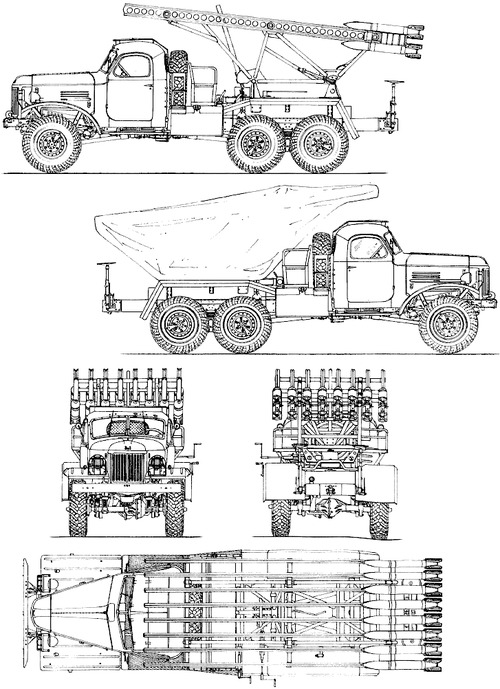 ZIL-157 BM-13/16 variant
ZIL-157 BM-13/16 variant
 ZIL-157 D-262 variant
ZIL-157 D-262 variant
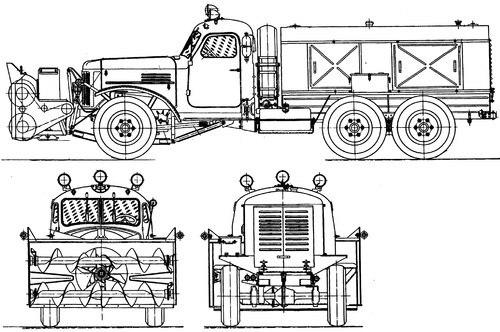 ZIL-157 D-470 variant
ZIL-157 D-470 variant
 ZIL 157K (1961)
ZIL 157K (1961)
⚙ ZIL-157 specifications |
| Weight | Curb 5,5t Gross 10,19t |
| Dimensions | 6,68 x 2,31 x 2,36 |
| Suspension | Leaf springs |
| Propulsion | ZIL-157K 5.55 litre 6-cyl. liquid cooled 80.2 hp (109) 2,800 rpm |
| Speed | 60 kph |
| Range | 150L fuel, 460 kph |
| Armament | None |
| Protection | None |
| Equipments | Spare tire, winch(K), roof rack, tarp. |
| Payload | 4.5 tons, plus 5 tons towed/trailer |
| Crew | 1 driver, 1 passenger, up to 16 troops |
A Chinese copy: The Jiefang CA-30

The ZIL-157 was also massively exported and produced under licence, notably by China as the
Jiefang CA-30, largely distributed to the North Vietnamese among others. The Jifang was itself produced from 1958 (at the same time as in USSR, it was the latest and best) until 1978, just like at ZIL. It was a product of pre-Sino Soviet split and motivated a lot of engineering follow-up in Chinese trucks. Another legacy of the Studebaker US5.
The ZIL-157 in service
Part in writing, also linked to exports and combat seen with threse operators. The ZIL 157 was exported to Finland, Indonesia, Iraq, North Korea, Syria, Egypt, and Ukraine (captured). The licenced Jiefang CA-30 was cheaper and used on large quantities by North Vietnam, Albania, Bangladesh and possibly North Korea also.